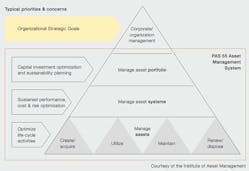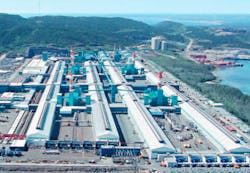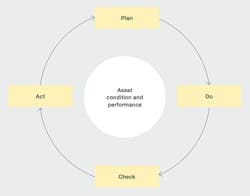The consequences of an out-of-date or inaccurate asset register can be catastrophic. Consider the real-life example of an air breaker failure in a substation: If these failures are not recorded in the asset register, there is no way to track and maintain the breakers to prevent future occurrences. When a company that suffered a fatality due to a breaker failure addressed this issue, it discovered more than 10,000 unregistered air breakers. This unfortunate case involves just one asset type in one business area; across asset intensive industries almost every company has a significant register of assets that have to be tracked, evaluated, risk estimated, costed, audited and so on. Not surprisingly, in the past, each company had its own idea as to how best to manage their assets – there was no industry standard to drive harmonization. Now, with the advent of the PAS 55 specification, all that changes.
1 PAS 55 overview
PAS 55
Industry experts at the UK-based Institute of Asset Management, in collaboration with the British Standards Institute (BSI), developed PAS 55 as a guide to optimizing asset management efficiency. First published in 2004 and revised in 2008, PAS 55 provides clear definitions and a requirements specification for establishing and verifying a comprehensive, optimized management system for all types of physical assets throughout their life cycle ➔ 1. Similar in approach to the ISO 9000 series specifications, PAS 55 is non-prescriptive and outcome based; it describes what to do, not how to do it.
Now internationally recognized, PAS 55 is proving to be an essential, objective definition of what is required to demonstrate competence in asset management, establish improvement priorities and make clearer connections between strategic organizational plans and the day-to-day realities of asset and work management. PAS 55 is expected to develop into ISO standards (ISO 55000, ISO 55001 and ISO 55002) this year.
This introduction to PAS 55 and some key aspects of asset management also describes how the Ventyx Ellipse enterprise asset management (EAM) solution has been developed specifically to align with PAS 55 and to support a PAS- 55-compliant asset management life-cycle approach for asset-intensive businesses.
Challenges and opportunities
To manage cost and risk and align operations with business strategy, organizations must be able to answer fundamental questions about their assets, such as:
- What assets do we have and what condition are they in? What function do they perform and does this function contribute value?
- Do we have appropriate capacity?
Are some assets redundant, underutilized, unprofitable or burdensomely expensive?
- Are the risks of our assets causing harm to people or the environment sufficiently low
- Can we accurately evaluate the performance, risk reduction, compliance and sustainability benefits of proposed asset work or investments and, likewise, the impact of delaying or not performing the proposed actions?
- Can we confidently address these lines of inquiry and provide answers to stakeholders with a clear audit trail and reliable data?
PAS 55 can help address these questions.
What assets does the company have?
A reliable and comprehensive asset register is central to all asset management activities. It should provide information on asset location, condition, failure risk, depreciation and replacement ➔ 2.
2 A comprehensive asset register is essential especially when there are many spread-out assets.
While this may seem basic, obstacles can emerge if the list is not comprehensive:
- Inadequate record-keeping. Many mining companies, for example, lack adequately detailed records of their electrical and ventilation systems, despite having thousands of meters of them in the field.
- Age. Organizations responsible for public infrastructure often have assets dating back as far as 70 years – long before computerized asset tracking. This can mean searching potentially out-of-date and inaccurate paper records, if they exist.
- Disconnected silos of information. Transportation companies may operate multiple networks – due to geography, type of operation, or through merger and acquisition. Often these employ different systems and processes, so getting a single view of assets, their condition, and how they are being maintained can be difficult.
The PAS 55 specification helps ensure assets are accurately and comprehensively recorded in the asset registry. Automating the underlying foundation of this process calls for an EAM system with built-in business processes that accommodate the PAS 55 framework.
Risk of an asset-related disaster
Determining the level of risk associated with an asset-related failure is of the utmost importance. Asset failure can mean substantial financial costs from lost revenue, personal injury, equipment damage and environmental harm. How should maintenance be prioritized and scheduled to mitigate risk?
Understanding the risk and criticality of assets is a central theme of PAS 55 that the EAM system must account for. By applying the PAS 55 framework, consistency of processes deployed across sites can be improved and global operations tailored to ensure risk of disaster is minimized.
Current condition of critical assets
When critical assets are not running, the company is not making money from them. And assets are often spread across a wide geographic area, making it difficult to get an overview of their condition. To combat this, PAS 55 delivers a comprehensive framework for evaluating asset condition – taking historical inspections, repairs and maintenance into consideration.
Corrective versus preventive maintenance
The financial implications of corrective versus preventive maintenance strategies can be substantial:
- Cost of maintenance. A general rule of thumb is that reactive work is two to three times more expensive than proactive work.
- Cost of part failure. The cost of replacing a failed part is often significantly higher than the cost of proactively maintaining it.
- Cost of an outage. Unplanned failure of an asset may lead to longer downtime and more lost production than a planned replacement shutdown would have done.
The correct application of asset maintenance strategies can ensure overall costs are minimized while operational effectiveness is maximized. Asset management based on a PAS 55 framework assists with this. The systematic collection of quality data enables corrective (or reactive) maintenance costs to be identified and compared with preventive (or proactive and predictive) maintenance costs. This informs decisions within maintenance programs and effectively balances the risk of asset failure against the overheads of preventive maintenance.
Assets – repair or replace?
Decisions on whether to maintain or replace equipment call for detailed asset records, including historical and comparative data – as well as an EAM solution designed to support the recommended best practices of PAS 55.
When it is properly maintained, an asset's life can be extended – significantly increasing the return on capital invested. The EAM system should include all the functionality required to manage replacement or refurbishment options over an extended time.
PAS 55 helps define the information that is required – and smart enterprise software simplifies maintenance of equipment using templates and processes specific to the precise operating conditions faced by the miner, steelmaker, railway operator, etc.
PAS 55: business value
Asset-intensive businesses are well aware of the value of best-practice asset management for reducing costs and risks, and for facilitating regulatory compliance. Nearly every asset-intensive operation is under increasing pressure to control costs and maximize return on assets, while providing high service quality and continuing to protect the safety of employees and the public. Environmentally conscious initiatives are, likewise, growing in importance with regulators, stockholders and consumers.
In contrast to some other standards or specifications, which can sometimes be met simply by generating extensive paperwork, PAS 55 specifically requires evidence of alignment between good intentions and the actual day-to-day activities of capital project implementation, operations, and maintenance. Thus, PAS 55 is a valuable mechanism in ensuring confidence in results and in supporting good governance, long-term planning and sustainable performance.
The ability to demonstrate compliance with PAS 55 not only reduces operational and compliance costs and risks, it also drives competitive advantage through improved service and greater operational proficiency.
Embracing the PAS 55 specification helps asset-intensive businesses to:
- Align the asset management strategy and approach with the overall business strategy
- Improve the integration between asset management and financial management processes
- Maximize return on assets
- Maximize asset uptime
- Foster an organizational culture focused on quality, safety, and continuous improvement
Applicability of PAS 55
PAS 55 is most relevant to asset-intensive businesses like mining, oil and gas, energy, utilities, and public infrastructure including roads, rail and ports. For these organizations, asset performance is central to the business objective.
Significant investment and ongoing expense and risk are associated with the acquisition, creation, utilization, maintenance, renewal and disposal of asset portfolios in such enterprises. Strong regulatory accountability for the safe management of assets and related services is a further driver for the adoption of PAS 55.
The PAS 55 approach
Optimal management of assets and related costs, risks and performance requires a pragmatic, life-cycle approach. One needs to determine what assets to build or obtain, how best to maintain and use them, and how best to renew, recondition or dispose of them.
3 The plan-do-check-act cycle for continuous improvement
The PAS 55 approach to whole-life asset management is based on the widely used plan-do-check-act (PDCA) cycle for continuous improvement ➔ 3. The components of the PDCA cycle can be directly applied to asset management by PAS 55 ➔ 4. Key elements that drive the asset management PDCA cycle include:
- An asset management policy to provide direction on how to manage physical assets in line with the organization's goals and objectives and to guide EAM system configuration.
- Asset management strategy, objectives and plans. This enables preemptive defect detection.
- Asset management enablers. This is the organizational structure of roles, responsibilities and authorities that aligns with the asset management policy, strategy, etc. This is essential because accountable people, not policies, bring about sound asset management.
4 The components of the PDCA cycle can be directly applied to asset management by PAS 55
How Ventyx Ellipse supports PAS 55
Ventyx Ellipse is a fully integrated EAM solution that provides complete visibility and management of enterprise-wide assets to a wide range of industries.
Ellipse has been designed from its inception to support good asset management practice. Since the introduction of PAS 55 in 2004, Ventyx has made alignment with this emerging standard a core development priority. Ongoing Ellipse product development since that time has focused on supplying a fully PAS-55-compliant offering, with all new or redesigned functionality being guided by PAS 55.
PAS-55-compliance starts in the DNA of Ellipse. It has not been achieved merely by mapping feature descriptions to the wording of the specification, but by thoughtfully engineering the product across two major releases with PAS 55 as basic design guidance.
Ellipse is aligned with PAS 55 most fundamentally in its inherent focus on proactive risk assessment and comprehensive support for corrective and preventive actions, versus the identification and remediation of after-the-fact performance failures. In particular, the Ellipse "manage physical assets" process follows and embodies the PDCA process that is the guiding principle of PAS 55 ➔ 5.
5 The Ventyx Ellipse "manage physical assets" process parallels PAS 55.
The core functional capabilities of Ellipse align with PAS 55 guidance by enabling asset-intensive businesses to achieve these key PAS 55 mandates:
- Manage risk before it becomes a problem
- Know the condition of every asset
- Standardize the asset registry business process
Asset futures
PAS 55 provides a clear, internationally recognized definition of what good practice asset management means for any organization. It provides detailed guidance and examples for demonstrating competent governance of critical assets, along with a checklist of good practices in asset life-cycle planning and cost/risk optimization, and an extensive glossary of terms that provides a common language for all stakeholders.
Developed over more than six years with help from over 50 public and private organizations in 10 countries and 15 business sectors, PAS 55 has earned broad, enthusiastic acceptance and is in widespread use. It represents a huge stride forward in the consistent application of asset management techniques. Perhaps most importantly, PAS 55 is driving more realistic and risk-sensitive asset management decisions at boardroom levels.
Since it was first published in 2004, Ventyx has been at the forefront of supporting its customers to align with PAS 55. Ventyx has also applied PAS 55 at the foundation of its EAM software design and development methodology, such that Ventyx Ellipse delivers comprehensive compliance with and support for PAS 55 guidelines today. Ellipse makes it straightforward for asset-intensive businesses to adopt PAS 55 and achieve commensurate benefits in cost and risk reduction.
Gordon J Melvin
John Benders
Ventyx, an ABB company
Brisbane, Australia
[email protected]
[email protected]







